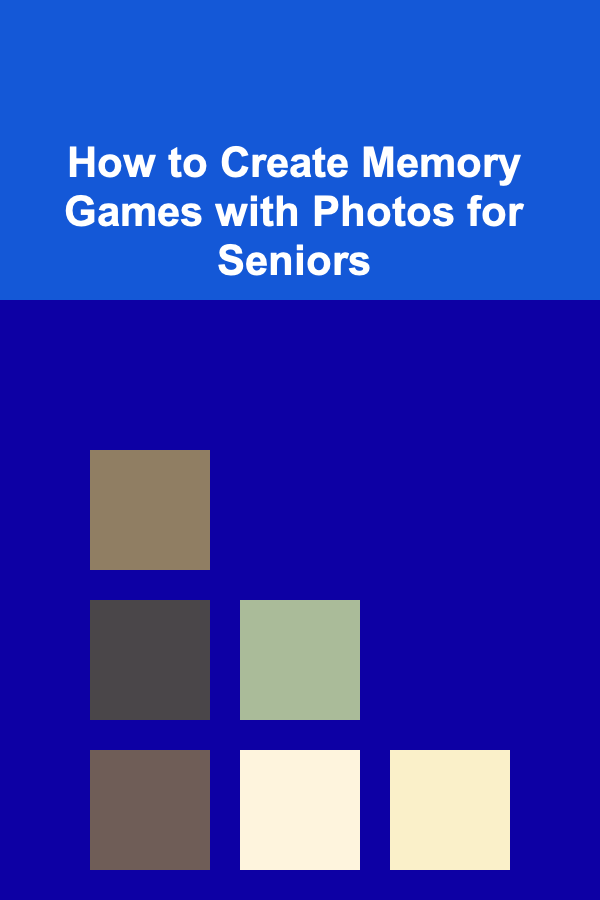
How to Create Memory Games with Photos for Seniors
ebook include PDF & Audio bundle (Micro Guide)
$12.99$8.99
Limited Time Offer! Order within the next:

As we age, our cognitive abilities may begin to decline, making everyday tasks more difficult to perform. Memory loss is one of the most common issues older adults face, particularly in cases of Alzheimer's disease or other forms of dementia. However, stimulating cognitive exercises, such as memory games, can help improve cognitive function, boost mental clarity, and provide emotional engagement. One of the most effective ways to create these games is by using photos that are meaningful to seniors.
In this article, we will explore how to create personalized and fun memory games with photos for seniors. These games can help stimulate their minds, enhance their memory, and offer an enjoyable way to engage with family members. We will discuss why photo-based memory games are so beneficial, how to choose the right photos, how to create a variety of games, and tips for making the experience as enjoyable as possible.
The Benefits of Memory Games for Seniors
Before diving into how to create photo-based memory games, it is essential to understand why these types of games are so beneficial for seniors. Here are some of the key benefits:
1. Cognitive Stimulation
Memory games are a fun and interactive way to stimulate the brain. They help seniors focus on recalling information, boosting short-term memory, and encouraging the brain to stay active. With regular practice, seniors can maintain cognitive function, slow down memory decline, and reduce the risk of dementia-related conditions.
2. Emotional Connection
Personalized memory games using photos create an emotional connection for seniors. By using pictures of loved ones, favorite places, or special moments, the games evoke nostalgia and help seniors tap into their long-term memories. This emotional connection can reduce anxiety, loneliness, and depression, promoting overall well-being.
3. Social Engagement
Memory games can also serve as a social tool. When played with family members, caregivers, or other seniors, these games encourage communication, interaction, and shared enjoyment. The sense of companionship and connection can improve mood and make seniors feel more engaged with the world around them.
4. Improved Focus and Attention
Playing memory games requires concentration and focus, which helps seniors practice their attention skills. By gradually increasing the difficulty of the games, seniors can challenge themselves to improve their focus, which is an essential cognitive skill.
5. Fun and Enjoyable
Memory games are not only beneficial but can also be fun and entertaining. By adding photos, seniors can reminisce about fond memories and enjoy a game that holds personal meaning. This sense of enjoyment is crucial to maintaining a positive outlook on life.
Choosing the Right Photos for Memory Games
When creating memory games for seniors, the most important factor to consider is the selection of photos. Personalized pictures are key to making the game more meaningful, effective, and engaging. Here are some tips for choosing the right photos:
1. Familiar Faces
Photos of family members, friends, and loved ones are ideal for memory games. Seniors are likely to recall these people with ease, especially if they have strong emotional connections to them. Include photos of children, grandchildren, spouses, siblings, and close friends.
2. Favorite Places
Images of places that hold significance for seniors, such as their childhood home, a favorite vacation spot, or a beloved park, can also make great game material. These types of photos often evoke happy memories and provide visual cues that are easier for seniors to recognize and recall.
3. Personal Milestones
Consider using photos that reflect important milestones in the senior's life, such as a wedding, graduation, or special family event. These moments are often deeply embedded in memory, and revisiting them through photos can stimulate recall and provide a sense of accomplishment and pride.
4. Hobbies and Interests
Seniors often have hobbies or activities that they have enjoyed throughout their lives, whether it's gardening, painting, playing music, or a specific sport. Include photos that reflect these interests to create a more engaging and relatable experience.
5. Clear and High-Quality Images
Ensure the photos you choose are clear and of high quality. Blurry or pixelated photos can be confusing and may hinder the memory game experience. Also, use close-up images that emphasize key details, such as the faces of people or the landmarks of a place, to make recognition easier.
Types of Photo-Based Memory Games
Now that you've selected the appropriate photos, you can start creating memory games that will engage seniors in a fun and mentally stimulating way. Here are some different types of photo-based memory games:
1. Matching Pairs Game
A classic memory game, the matching pairs game involves placing photos face down on a table and having the player flip over two pictures at a time, trying to find matching pairs. The goal is to match identical photos, such as two images of the same family member or two photos from the same vacation.
How to Create:
- Print out two copies of each photo.
- Shuffle and lay them face down in rows.
- The senior will take turns flipping over two photos at a time, trying to find matching pairs.
- Keep track of matches and the number of attempts it takes to match all pairs.
This game helps improve memory recall and concentration while also being simple and enjoyable.
2. Photo Recall Game
The photo recall game challenges seniors to remember and recall specific details about photos they are shown. After looking at a series of photos, the senior must answer questions about the people, places, or events depicted.
How to Create:
- Prepare a set of 5-10 photos related to meaningful memories.
- Show the senior the photos one by one for a brief period (e.g., 1-2 minutes).
- Afterward, ask the senior questions like:
- "Who is in this photo?"
- "Where was this photo taken?"
- "What event is happening in this picture?"
This game encourages recall, improves attention to detail, and helps seniors connect with their past.
3. Photo Puzzle Game
A photo puzzle game involves cutting a photo into smaller pieces and challenging the senior to reassemble it. This game combines cognitive challenges with tactile engagement and provides a sense of accomplishment when the puzzle is completed.
How to Create:
- Select a photo that is meaningful to the senior.
- Print and cut the photo into puzzle-sized pieces (you can start with a smaller number of pieces and increase difficulty).
- Mix up the pieces and ask the senior to put them back together.
This game enhances problem-solving skills, spatial awareness, and patience.
4. Memory Album
A memory album is a more elaborate game where you compile a photo album of personal memories and allow the senior to flip through the pages. As they look through the album, ask them to recall the stories behind each photo, such as where they were when the photo was taken or what they were doing.
How to Create:
- Create an album with a series of photos from different stages of the senior's life.
- Include captions or notes on the photos to prompt memory recall.
- Ask the senior to share stories and details about each photo.
This game encourages storytelling, social interaction, and mental stimulation while fostering a deep emotional connection.
5. Spot the Difference Game
In this game, you present two almost identical photos and ask the senior to find the differences. This game helps improve attention to detail and enhances cognitive function by requiring seniors to focus on subtle variations between the images.
How to Create:
- Select two nearly identical versions of a photo (you can use photo-editing software to create slight differences).
- Ask the senior to identify the differences between the two photos, such as a missing object, a change in color, or a shifted detail.
This game promotes focus, visual recognition, and mental sharpness.
Tips for Success
Creating memory games with photos for seniors can be a rewarding experience, but there are a few tips to ensure that the games are as effective and enjoyable as possible:
1. Adapt to the Senior's Cognitive Ability
Always consider the cognitive ability of the senior when designing memory games. For individuals with more advanced memory loss, keep the games simple and use fewer images. For those who are more cognitively intact, you can increase the difficulty level with more complex games.
2. Encourage Social Interaction
Play the games together as a family or with other seniors. Social interaction enhances the overall experience and provides an opportunity for shared memories and bonding. The collaborative nature of the game encourages conversation and emotional connection.
3. Provide Positive Reinforcement
Encourage the senior with positive reinforcement throughout the game. Whether they are successful or not, praise their efforts and create a supportive atmosphere. This boosts confidence and helps make the experience enjoyable.
4. Limit Distractions
To maximize focus, minimize distractions in the environment. A quiet, well-lit space will help seniors concentrate better and engage more fully in the memory games.
Conclusion
Memory games with photos offer a fun and meaningful way to help seniors maintain cognitive function, reminisce about important memories, and stay socially engaged. By carefully selecting meaningful photos and creating various types of games, caregivers and family members can provide an enjoyable and mentally stimulating activity that improves focus, memory, and emotional well-being. Whether through matching games, photo puzzles, or memory albums, these simple yet effective activities create opportunities for seniors to reconnect with their past while enjoying the present moment.
Reading More From Our Other Websites
- [Organization Tip 101] How to Arrange Pet Feeding Areas for Convenience
- [Organization Tip 101] How to Share Your Jewelry Organization Tips with Friends
- [Home Holiday Decoration 101] How to Transform Your Front Porch into a Holiday Haven
- [Home Staging 101] How to Stage a Hallway and Make a Strong First Impression
- [Organization Tip 101] Why You Should Reassess Your Storage Solutions Regularly
- [Home Holiday Decoration 101] How to Make a Statement with Holiday Wreaths in Your Home
- [Star Gazing Tip 101] Top 5 Astronomical Objects Every New Telescope Owner Should Observe
- [Stamp Making Tip 101] Integrating Custom Stamps into Mixed‑Media Art Projects
- [Personal Investment 101] How to Leverage Real Estate Investment Trusts (REITs)
- [Rock Climbing Tip 101] The Evolution of Iconic Bouldering Problems Around the World

Creative and Affordable Home Improvement Ideas to Boost Your Home's Value
Read More
Health Coach's Handbook: Tools and Techniques for Promoting Lasting Wellness
Read More
How to Conduct a Home Inventory for Insurance Purposes
Read More
How to Use the Pomodoro Technique to Boost Productivity
Read More
Interpreting Candlestick Charts for Crypto
Read More
How to Advance Your Career as an MLT: Specializations and Opportunities
Read MoreOther Products

Creative and Affordable Home Improvement Ideas to Boost Your Home's Value
Read More
Health Coach's Handbook: Tools and Techniques for Promoting Lasting Wellness
Read More
How to Conduct a Home Inventory for Insurance Purposes
Read More
How to Use the Pomodoro Technique to Boost Productivity
Read More
Interpreting Candlestick Charts for Crypto
Read More